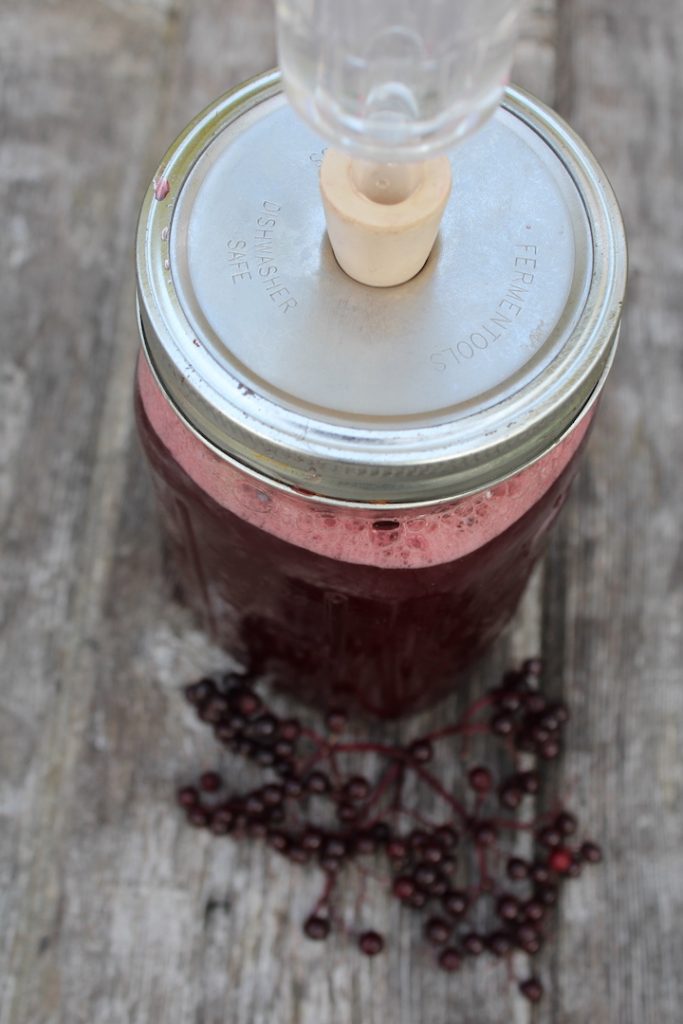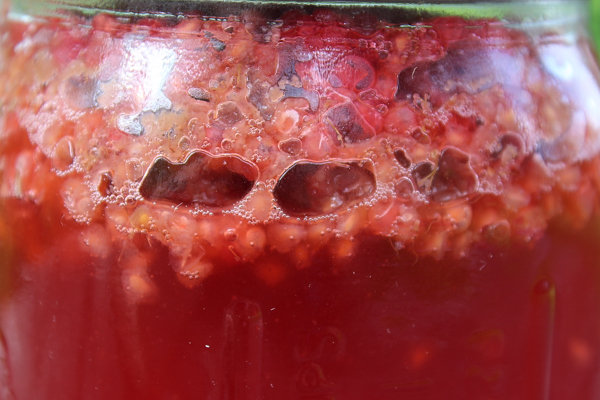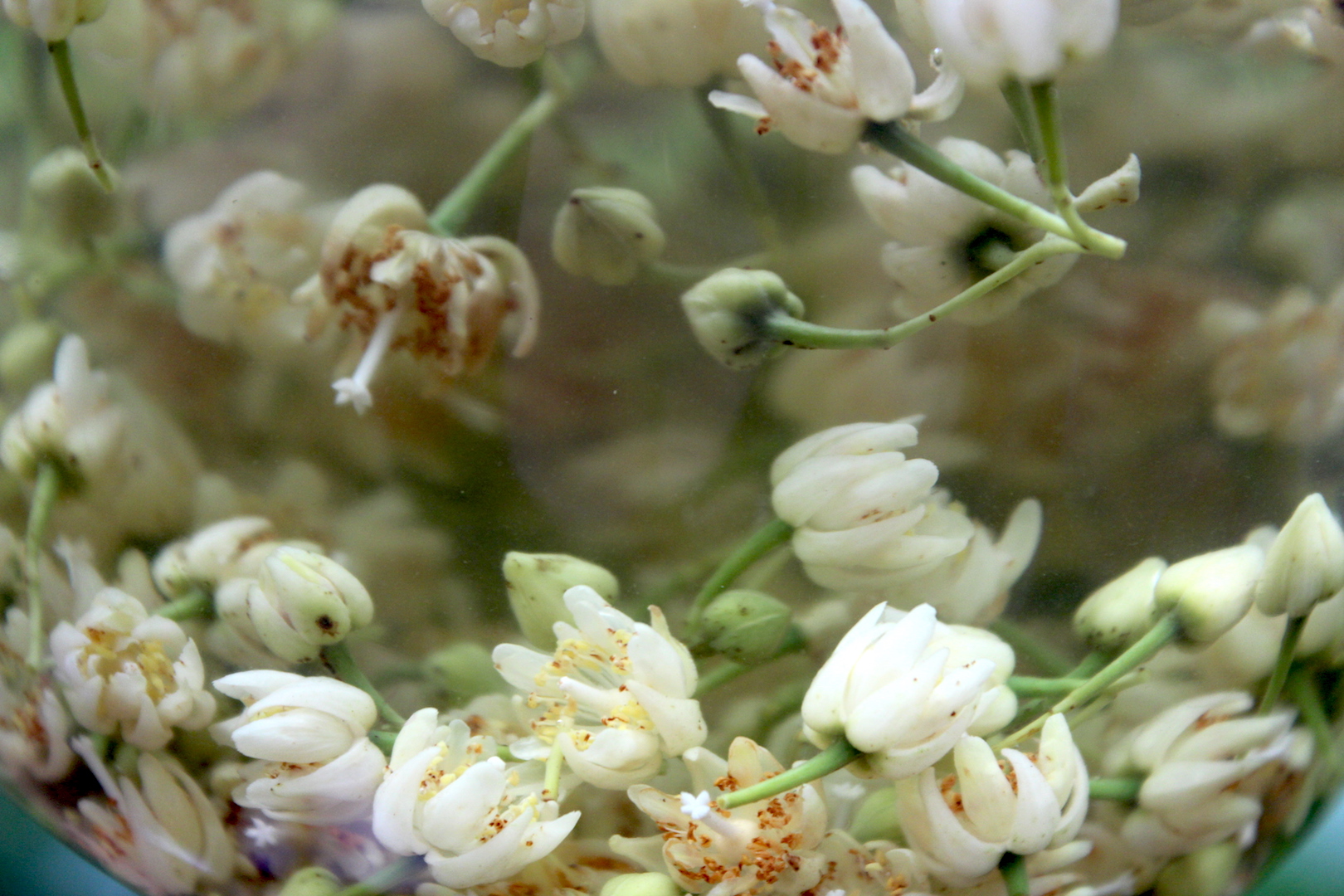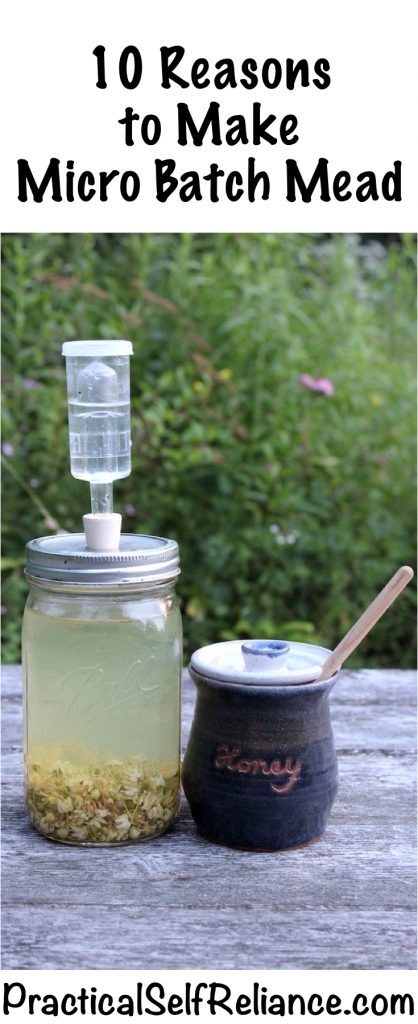Affiliate disclosure: This post may contain affiliate links. Please see our Privacy Policy.
These days, home brewers generally make mead in either 1 gallon or 5-gallon batches. Why? Mostly because that’s how the equipment is setup.
Brewing vesicles, or carboys, come in one gallon or five-gallon sizes, and the available equipment shapes how we brew.
Fermentation equipment is evolving. With the increased interest in home lacto-fermentation, there’s been a lot of innovation that helps both lacto-fermenters and home brewers alike.
New small-scale fermentation kits that adapt mason jars into home fermentation vesicles are readily available. With a mason jar fermentation kit, any wide-mouth mason jar (pint, quart or half-gallon) can be turned into a fermentation carboy for your own micro-batch meads.
There are a lot of reasons to scale down your batch and make micro brew quantities. Depending on the brew, as little as a pint may be appropriate for medicinal brews or something experimental.
If you don’t need convincing, here’s a basic primer on how to make your first 1 quart batch of mead. Otherwise, read on…

10 Reason to Make Micro Batch Mead
1. You Love to Brew
Once you get started home brewing your hobby can quickly spiral out of control. Mead making is fun and relatively easy, and if you’re anything like me, once you get started brewing you’ll try to ferment just about anything that will fit into a carboy. After just a few years of home brewing, an inventory of our basement mead cellar found over 200 bottles!
How could this happen? It’s going to be along time before we drink through that many bottles. Even though most batches were great, we’ve actually made way more than we want to drink.
It’s a sad thing when you find yourself excited to make home brew, but can’t because you’ve put yourself on brewing restriction. Don’t let that happen to you!
2. You Want to Experiment
Want to try something particularly strange and see how it goes? How about switching out the honey and trying an agave nectar and lime ferment? That one, in particular, you can skip.
We made it. It was horrible. Now we have lots of extra bottles full of that funk that nobody wants to drink.
By starting with a very small batch, you can test out flavors and proportions without wasting a lot of ingredients.
3. You Like Brewing More Than Drinking
Regardless of how much or little you like to drink, if you love to ferment and craft unique home brews then your brewing desire might well outpace your ability to drink it all. Sure, you can host parties or give your extra brews away to your friends, but scaling back might be better for everyone’s liver in the long run.
4. You’re Making a Messy Batch
Brewing carboys are notoriously hard to clean. A narrow neck is great to reduce the amount of surface air in the fermenter, but after you’ve brewed once or twice with fruit and spent hours trying to scrape every last speck of pulp off the inside with a carboy brush you’ll wish you were using a wide mouth jar instead.

5. You’re Brewing With Medicinal Herbs
Home brew is a great way to consume medicinal herbs. Meads and beers are traditional vehicles for the medicinal components of herbs, and while herbalists are more fond of the convenience of tinctures these days, mead and beer were once the best way to preserve the potent medicines harvested from the wild.
If you’re interested in herbal brewing, I’d suggest reading Sacred and Herbal Healing Beers. The author focuses on beer, but the same herbs are equally applicable in medicinal meads.

6. You’re Making a Gift
Have a friend that loves something that you hate? Maybe they’re particularly fond of lemon and you can’t stand it. When you’re making a gift, their tastes matter more than yours, but it’s understandable that you wouldn’t want any extra hanging around.
A gallon batch makes 4 wine bottles, which is a bit excessive for most people’s gifting tastes. Try making a quart batch and you’ll have just enough for the perfect gift bottle.
7. You Want To Save Money
If you’re a mead maker you’ve been following the plight of the honeybee. They’re in rough shape these days, and consequently, honey prices have increased.
You still want to support beekeepers, but honey prices have more than tripled in the past few years. A pound of local honey that could be purchased for $2 is now at least $6.
The standard for a 5-gallon batch is 15 pounds of honey, and once you add in the cost of yeast and any other flavorings, you’re easily spending $100 or more. A half-gallon batch on the other hand costs about $10.
Beyond the cost of ingredients, a full 5-gallon batch home brew setup is expensive. Most crafters, canners and cooks have mason jars handy, and brewing in a mason jar only requires switching out the lid and adding an airlock.
8. You’re Working with Foraged Ingredients
Foraging and mead making go hand in hand and foraged brews make some of the most unique homemade meads. Oftentimes, foraging trips only bring home a handful of the best ingredients.
Maybe you want to make a linden flower mead, but you could only reach a handful of the blossoms? A handful is plenty for a small batch quart.

9. You Don’t Have A Lot of Space
Brewing equipment takes up a lot of space. Even a single batch going at once will dominate a closet or corner of the room in a small apartment.
Once you bottle it, do you have space for 20 bottles from a 5-gallon batch? What happens when you want to try out several brews at once? Quart and half-gallon batches easily fit on the kitchen countertop and take up very little space once bottled.
10. You’re Using Specialty Honey
Every honey is unique, and there are a number of exciting artisanal honeys made around the world that have their own flavor and characteristics.
Pine honey is a spicy honey with medicinal benefits that’s produced in heavily forested areas where flowers are scarce, mostly in the Mediterranean. Pine honey mead has exceptional flavor, but at around $40 per pound, even the three pounds required for a 1-gallon batch is a big investment.
Other specialty honeys that make great small-batch brews include lavender honey and eucalyptus honey.
What do you think? Are you ready to try a micro-batch mead on your countertop? Here’s a basic primer on how to make your first 1 quart batch of mead. Feel free to cut it in half to make a pint or double it to make a half gallon.
Let me know what you plan to make for your first batch in the comments.





I’m excited to try this! Wondering if there is any risk of cross contamination with the yeast that is in my kombucha skoby, and if you add fruit it can also bring in a yeast passenger, does it matter?
So in theory the water lock should help prevent this. Kombucha (and vinegar) ferment open, with a cloth covering, and a water lock is used to prevent them from proliferating within the yeast ferment. Of course, you can get some cross-contamination possibly, but clean everything like your equipment before you start, and the yeast you put in as a starter will dominate.
Do you have a bibliography of recommended books on all the subjects of your writing?
I don’t have a list of recommended books for any subjects I talk about on my blog except for permaculture, which you can find here:
I am wanting to make blueberry Mead do you know how much frozen blueberries I would need to add to a quart
I generally go with a cup of fruit to a quart. For blueberries, muddle them up a bit first so the juice/flavor comes out of their skins better. Enjoy!
Thomas from Toronto here. I read your article and thought it was great! I went to the the local wine store, bought an airlock and a cork for around $3.50. Drilled a hole into a plastic reusable mason jar lid, and started a quart size batch using up the leftover honey sitting in my cupboard. Looking forward to the final product. Like the name of your website, very practical self-reliance. I look forward to reading your other articles over this winter to see what other tips I can make good use of. Keep up the great work!
Your neighbour North of the border
Hi!
Camed across this site when googling for lavendel honey and mead. Do you mind share your receipe for your laveldel honey mead or some specific like OG, FG and yeast?
/Peter
I don’t…yet. One of my next meads to make is a lavender mead, but I’m planning on infusing the honey with lavender rather than using lavender honey.
Can I use organic apple cider instead of water, and add less honey
Yes, of course you can. Cider and honey make something called a cyser, and it’s delicious!
Thanks I just finished a quart today
One thing that should be mentioned is to start a Mead or Home Brew diary. Write down what you did for each batch so you can look back at it later. In a year we made 23 batches of wine, Mead and beer combined. We couldn’t remember all those details so a diary is fun and helpful.
Any recipes?
So many, just haven’t written them up yet. This week and the next I’ll be writing up recipes for 4 different batches: linen flower, raspberry, black currant and elderberry. Along with a micro batch hard cider recipe. So much brewing, but much less time to write these days…
Thank you for the article. I’m one of those folks with mason jars always around from canning. My husband and i have been talking about home mead making forever. Friends just started beer brewing, but only via kits.. and they’re left over with lots they don’t like and the equipment and ingredients are expensive. This is a fabulous idea, so glad to hear about it. Can’t wait to try it.
Do you have any recipes for micro-batch mead? We’ve been thinking of trying to make some, but I’d rather start small…
All coming soon…
Hi Ashley, I enjoyed the article. I’m just starting to learn mead making. This was a prayer answered. My biggest concern has always been too much of something I don’t like or didn’t make correctly. The small batch approach satisfies my scale issues. I’ll be looking for the Linden flowers for a future batch. Thanks again. Bob
You’re quite welcome! It’s a lesson I had to learn the hard way for sure…
Where do you find the equipment to get started, I have always been interested!
Thanks for asking! I walk you through everything you need and how to get started with your first batch in this post linked below. I get all my supplies on Amazon. In a rural area, it’s the best way to get home brew and fermentation supplies.
https://practicalselfreliance.com/make-1-quart-mead-micro-batch-method/